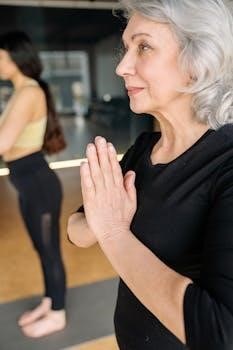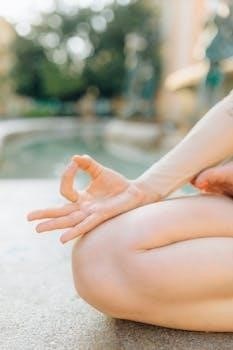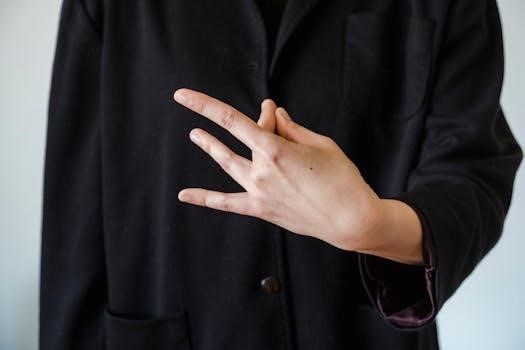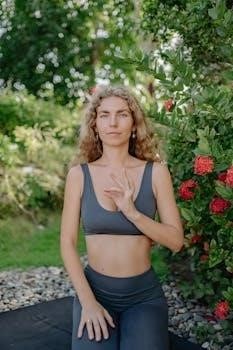Mudras are hand positions, gestures, and seals used in yoga to facilitate energy flow and induce specific states of mind․ They are a powerful tool for healing and psychological balance, working by preventing life force from dissipating․
What are Mudras?
Mudras, derived from a Sanskrit word meaning “delight” and “bring forth,” are ancient yogic gestures primarily involving the hands and fingers․ These symbolic positions facilitate the flow of vital energy, known as prana, throughout the body․ By preventing energy from dissipating from the fingertips, mudras create specific energetic circuits, influencing physical, mental, and spiritual well-being․ Mudras are not merely physical actions; they are potent tools that can be used for healing, psychological balance, and spiritual transformation․ Some mudras use the whole body and breath․ They are effective and easy to learn and can be practiced by anyone․ Originating from ancient Indian traditions, mudras are integral to yoga, meditation, and even classical Indian dance forms, offering a pathway to inner harmony and enhanced self-awareness․ The practice of mudras is a journey towards unlocking the body’s natural healing potential․

Types of Mudras
Mudras are categorized by body parts used, with Hasta Mudras (hand gestures) being most common․ Kaya Mudras involve the entire body, while Bandha and Adhara mudras complete the list․
Hasta Mudras (Hand Mudras)
Hasta Mudras, also known as hand mudras, are the most frequently practiced type of mudras in yoga․ These gestures involve the use of the hands and fingers to create specific shapes and positions, each believed to influence the flow of energy within the body․ By manipulating the fingers, we can direct prana, or vital energy, to specific areas, promoting healing and balance․ The practice of Hasta Mudras is accessible to everyone and is a convenient way to harness the power of mudras․ They are often performed during meditation, yoga asanas, or even in daily life․ The precise movements and positions of the hands are crucial to the effectiveness of these mudras․ There are numerous Hasta Mudras, each with its own unique benefits and purpose, such as Gyan Mudra, Prana Mudra, and Vayu Mudra․

Kaya Mudras (Postural Gestures)
Kaya Mudras, also referred to as postural gestures, involve the entire body in specific positions and movements, extending beyond simple hand gestures․ These mudras are designed to influence the flow of energy by engaging the whole physical form․ Unlike Hasta Mudras, which focus on hand positions, Kaya Mudras utilize a combination of body posture, movement, and breath to create a profound energetic effect․ These practices are often integrated into yoga asanas and meditation, helping to deepen the connection between the body, mind, and spirit․ Kaya Mudras can range from simple postures to more complex movements, requiring both physical awareness and inner concentration․ The intention behind the posture is as crucial as the posture itself, as it helps to direct the energy flow within the body, promoting balance and well-being․ They can be used to release tension and enhance one’s yoga practice․
Bandha Mudras
Bandha Mudras involve engaging specific muscle groups in the body to control and direct the flow of prana, or vital energy․ These mudras are often combined with breathing techniques and asanas to enhance their effects․ Bandhas are considered energy locks, which can help to contain and redirect energy within the body and prevent its leakage․ There are three primary bandhas⁚ Mula Bandha, which focuses on the pelvic floor; Uddiyana Bandha, which engages the abdominal muscles, and Jalandhara Bandha, which involves the throat․ When combined, these bandhas can create a powerful energetic effect, promoting stability, focus, and overall well-being․ Bandha Mudras are an advanced practice, and it’s best to learn them from an experienced instructor to avoid strain and injury․ They are a vital component of advanced yoga practices and are used to regulate energy flow․
Adhara Mudras
Adhara Mudras are a less commonly discussed category of mudras, often involving the use of the entire body or specific body postures․ These mudras work on a deeper level, influencing the subtle energy systems and promoting internal balance․ Some texts categorize these as postural gestures that encompass the whole body rather than just hands․ They are believed to affect the flow of prana, or vital energy, within the body by directing it to specific areas․ Adhara mudras are often used in more advanced meditation practices and require a deep understanding of the body’s energetic pathways․ They might include specific poses or the way the body is held during meditation․ These mudras are considered powerful and can lead to profound spiritual experiences if practiced with awareness and intention․ The application of Adhara Mudras in yoga practice is quite rare․

Specific Mudras and Their Benefits
Specific mudras, like Prana, Vayu, Gyan, and Anjali, offer unique benefits․ These hand gestures can improve physical health, enhance mental clarity, and promote spiritual growth by influencing energy flow in the body․
Prana Mudra
Prana Mudra, also known as the ‘life force’ mudra, is a powerful hand gesture that promotes the flow of vital energy throughout the body․ This mudra is believed to increase vitality, invigorate the immune system, and slow the aging process․ To perform Prana Mudra, gently join your thumb with your little finger and ring finger, keeping the middle and index fingers extended and relaxed․ This mudra can be practiced daily for 5-15 minutes to significantly improve health․ It helps in balancing the earth element and promoting stability․ It is used to enhance overall well-being and has therapeutic applications for both physical and mental health․ Prana mudra is often used in conjunction with meditation and breathing exercises to enhance its effectiveness․ Regular practice of this mudra can lead to a more energized and balanced life․ It is a fundamental mudra in yogic practices and is easy for anyone to learn and use․
Vayu Mudra
Vayu Mudra, also known as the ‘wind’ or ‘air’ mudra, is a hand gesture used to balance the air element within the body․ To perform Vayu Mudra, touch the tip of your index finger to the base of your thumb, then gently press the thumb over the index finger․ The other fingers should remain extended and relaxed․ This mudra can be done in any position, such as while walking, sitting, standing, or lying down․ It is particularly effective for addressing health conditions related to excess air in the body․ For therapeutic use, practice Vayu Mudra 2-3 times per day, for 10-45 minutes each session, until desired results are achieved․ This mudra helps to reduce excess air, relieve gas, and promote overall well-being․ Vayu mudra is a simple yet powerful tool for improving physical health and can easily be incorporated into your daily routine․
Gyan Mudra (Chin Mudra)
Gyan Mudra, also known as Chin Mudra, is a fundamental hand gesture in yoga and meditation․ It is formed by gently touching the tip of the thumb to the tip of the index finger, forming a circle, while keeping the other three fingers extended․ This mudra is traditionally performed during meditation asanas to enhance concentration and focus․ The Gyan Mudra is often associated with knowledge, wisdom, and receptivity․ It facilitates the flow of energy and improves the overall quality of meditation practice․ To perform this mudra, it’s best to sit in a comfortable meditative pose and gently rest the hands on the knees or thighs with palms facing up․ This simple yet powerful gesture helps to calm the mind and deepen the meditative experience․ Gyan Mudra can be practiced anytime, anywhere to promote mental clarity and spiritual awareness․
Anjali Mudra
Anjali Mudra, often accompanied by the word “namaste,” is a gesture of greeting, salutation, and reverence․ It is performed by pressing the palms together at the heart chakra, with fingers pointing upwards․ This mudra symbolizes the belief that there is an inner light within each individual’s heart․ In practice, it embodies respect, humility, and the unity of self․ Anjali Mudra is a common practice in yoga and meditation․ It is frequently used to begin and end yoga sessions and is a sign of gratitude․ This gesture helps create a sense of peace and connection․ It is also a form of acknowledging the divine within oneself and others․ Anjali Mudra can be used in daily life to foster a mindful and respectful attitude․ It is a simple yet powerful gesture that brings a sense of calmness and centeredness․ This is a common mudra in the Indian culture․

Mudras in Practice
Mudras are effective and easy to learn, they are practical and powerful, and anyone can do them․ These gestures can be incorporated into daily life with regular practice for maximum benefit․
How to Perform Mudras
Performing mudras involves specific hand and finger positions that facilitate energy flow in the body․ Begin by finding a comfortable seated position, ensuring your spine is straight and your body is relaxed․ Gently bring your hands into the desired mudra, using the fingertips, joints, or palms as needed․ It’s important to be gentle and not force any position․ Maintain light pressure, and breathe deeply and calmly throughout the practice․ Visualize the energy moving within you as you hold the mudra․ You can use mudras in any position, walking, sitting, standing or lying․ Consistency and awareness are key to experiencing the benefits of mudra practice․ You should try to be as relaxed as possible while holding the mudra․ Focus on feeling the energy while breathing deeply and regularly․
Duration and Frequency of Practice
The duration and frequency of mudra practice can vary depending on individual needs and the specific mudra being used․ Generally, practicing a mudra for 5 to 15 minutes daily can offer significant health benefits․ For some conditions, it’s recommended to practice 2-3 times per day, with sessions lasting 10 to 45 minutes․ Consistency is more important than the duration of each session․ Regular daily practice is key for experiencing the benefits․ Pay attention to how your body responds, and adjust the duration and frequency of your practice as needed․ Some mudras can be practiced for longer durations, while some are better suited for shorter periods․ There are also cases when you should continue until you get the desired results․ Always listen to your body and do not push yourself too hard․